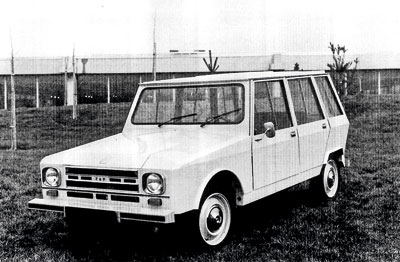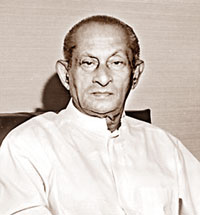Sunday Times 2
The Royalists and the Citroën project
View(s):My father, the late Anil Moonesinghe (whom I shall hereon refer to as “Anil”, for the sake of brevity) became Chairman of the Ceylon Transport Board (CTB) in 1970. He had many state assets coming under his purview, including the huge workshops at Werahera, possibly the biggest in South Asia, as well as the workshop at Ekala.
While dealing with bus operations, he found time to set about putting these resources to work, to follow his dream of industrialising Sri Lanka. He realised the CTB had the potential to fulfil supply-chain requirements, from building bus bodies to fabricating the machinery required to build an actual bus.

FAF: A derivative of Citroen 2CV
He also dreamt of building a wholly-Sri Lankan car. He appreciated that the burgeoning middle class fumed, under a 14-year import-restrictions regime, especially due to their inability to buy a car. There had been several projects for assembling cars and jeeps, but he wanted to manufacture them.
He envisioned building up the industry from the basics: starting with a cheap, easy-to-build utility vehicle (intended for rural use) and, with gathered experience and expertise, gradually moving into more sophisticated products. This would have enabled the growth of a local components and spare parts manufacturing industry.
At this point, Scott Direckze (who also passed away recently), a fellow alumnus of Royal College, Colombo, learnt about his endeavour.
“About the same time,” wrote Scott later, “I too was very keen on trying to interest some organisation in assembling (what a view to future manufactured) the Citroën 2CV, a basic, but highly ingenious small car immensely popular with the less affluent in France. Since the car had been designed in 1935, I felt the manufacturing facilities available in Sri Lanka 35 years later would perhaps be adequate for the purpose.”
Scott probably chose the 2CV because (as yet another Royalist, Gamini Seneviratne relates) he had a collection of Citroëns, one of which, a 2CV van, he drove around his father’s paddy holding in Anuradhapura, finding that “it took ruts and depressions with ease.”
The 2CV (or Deux Chevaux – meaning “two horses” for its declared taxable horse power rating), helped put millions of middle class people in cars on the roads of France. This number, included a large number of farmers who used horses and carts – it had been designed with them in mind, able to carry a basket of eggs across a ploughed field without breaking any.
The soft transmission made it comfortable on country roads, and its handily-removable back bench seat and soft top made it an ideal utility vehicle. Its robust air-cooled engine required a minimum of maintenance, could be repaired cheaply, and thrifty on petrol.

Anil Moonesinghe
Shortly after the end of the abortive 1971 insurrection, Scott put the idea to Anil, who proved highly enthusiastic. Scott, therefore, approached Grahame Young, of the London merchant bank Arbuthnot Latham, and the two of them visited Citroën in Paris. In November 1971, Scott and Young took Citroën’s representative Jacques Eyraud to meet Anil, Finance Minister Dr NM Perera and Trade Minister TB Illangaratne “who,” said Scott, “gave us their blessings for the project.”
The CTB imported a 2CV, which Anil used as an official vehicle, and a couple more chassis. Eyraud envisioned the production of a derivative of the 2CV, known as the FAF. Citroën developed the FAF – standing for Facile à Fabriquer, Facile à Financer (easy to build, easy to fund) – as a concept for manufacturing a range of vehicles, based on the 2CV chassis and running gear, in the Third World.
Citroën claimed that manufacturing the FAF, designed so that local manufacture account for at least 50% of the vehicle, reduced import duties and provided local employment, while creating a national motor industry instead of merely assembling largely imported components. The vehicle actually saw production in two versions in Greece, as well as in other countries such as Indonesia, Portugal, Spain and (surprisingly) Britain.
According to Scott, Eyraud was highly impressed with the workmanship of the fabrication work at Werahera, as well as the castings produced there for gear box housings. Wrote Scott, “Eyraud said that 60 per cent of the parts for the 2CV could be manufactured locally in year one and 97 per cent by year five. He came to this conclusion after visiting the CTB’s Werahera workshops and the Lanka Leyland factory premises near Homagama. He said Citroëns would supply any parts that could not be turned out locally.”
Scott took his proposal to Gamini Seneviratne, now Director, Regulation of Industries, at the Ministry of Industries, who dealt with the private sector. Scott already knew Gamini, as the only other Sri Lankan fellow owner of a Citroën Light 15 – a revolutionary saloon car, featuring front wheel drive, four-wheel independent suspension and a monocoque body.
“By then,” relates Gamini, “Anil had got his people to work on components for a 2CV at Werahera and Walkers turned out some too. It was to be assembled at Ekala.”
This writer remembers seeing the Sri Lankan FAF prototype under construction at Werahera, being rushed through in time to put it on display at the Republic Day parade on May 22, 1974, at which (together with the Werahera-made Lanka 1 bus prototype) it caused quite a stir.
Everything was set for production, and the car could have been sold for Rs 12,000 – a fairly reasonable price for the time (the imported cab-chassis-engine for the Peugeot 404 diesel light lorry cost Rs 34,000 at the time, while a second-hand Sri Lankan assembled Mitsubishi Colt 1100 went for Rs 38,000).
However, according to Gamini, there was a problem with the suspension system, for which Citroën had a patent. This required negotiating payment of royalties (7% according to Gamini) on the technology. Unfortunately, this proved to be a sticking point, and the deal fell through.
Undaunted, Anil turned to the French state-owned manufacturer Renault, with a view to manufacturing a similar vehicle to the FAF. This he failed to achieve, although about 50 of these vehicles were made by the private sector, based on the Renault 4 chassis.
After leaving the CTB, Anil negotiated with Britain’s Reliant Motor Company, to build its glass-fibre-reinforced plastic (GRP) bodied Fox utility vehicle (which saw production in Greece), based on its popular Kitten hatchback. Again, the deal fell through, because the imported component would be too expensive.
By this time, the new government of J.R. Jayewardene had liberalised vehicle imports. Sri Lankans in Britain began frenzied buying of Morris Minors and Oxfords, and Austin Cambridges. Within six months, the disposable price of a Morris Minor shot up from about £50 to £500. The ensuing flood of cheap cars, mainly second hand or “reconditioned”, led to the collapse of local assembly of “Upali” Fiat 128s and “Unimo” Lancers.
Thus died Anil’s dream of a Sri Lankan motor manufacturing industry, at a time when, according to Scott, motor manufacturers accounted for about 8% of GDP of developed countries, on average. The country lost a golden opportunity to develop a vertically-integrated manufacturing industry.
- Vinod Moonesinghe

